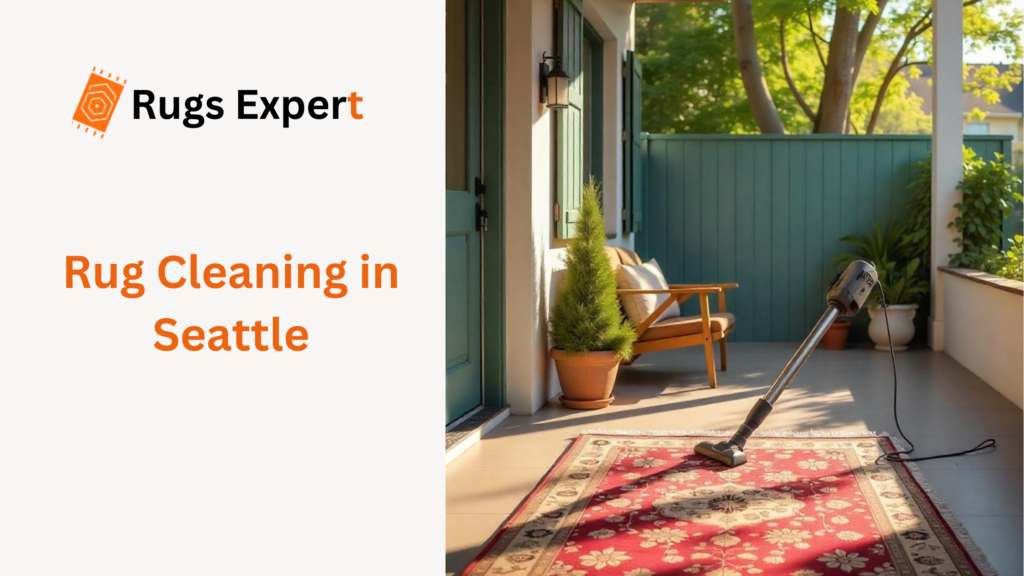
In the Emerald City, where rain and moisture are constant companions, proper rug maintenance isn’t just about aesthetics, it’s essential for protecting your investment and maintaining a healthy home environment.
Also Read: How Much Do Rugs Cost in 2025? Find the Best Deals Today!
Whether you own a treasured Persian heirloom or a modern synthetic area rug, understanding the unique challenges of Seattle’s climate is crucial for proper rug care.
The Importance of Professional Rug Cleaning in Seattle’s Unique Environment
Seattle’s climate presents specific challenges for rug owners. With an average of 152 rainy days per year and humidity levels often exceeding 70%, rugs in Seattle homes face increased risks of:
- Mold and mildew development
- Dust mite infestations
- Allergen accumulation
- Premature fiber breakdown
- Stubborn water stains
According to a study by the University of Washington’s Indoor Air Quality Research Center, area rugs can trap up to five times their weight in dirt, dust, and allergens—particularly problematic in Seattle’s damp climate where these particles can lead to respiratory issues if not properly removed University of Washington Indoor Air Quality, 2023.
Types of Rugs Common in Seattle Homes

Different types of rugs are being discussed below:
Persian and Oriental Rugs
These high-value rugs are particularly popular in Seattle’s historic homes and luxury condominiums. Made with natural dyes and delicate fibers, these rugs require specialized cleaning methods to preserve their beauty and value.
Cleaning Considerations: Persian and Oriental rugs should never be cleaned with harsh chemicals or excessive moisture. Professional cleaners in Seattle who specialize in these rugs typically use gentle hand-washing techniques and controlled drying environments.
Natural Fiber Rugs
Seattle’s eco-conscious homeowners often choose sustainable options like:
- Wool rugs: Naturally stain-resistant, but can shrink if improperly cleaned
- Cotton rugs: Machine-washable in some cases, but prone to color bleeding
- Jute and Sisal rugs: Highly susceptible to water damage, requiring specialized dry cleaning methods
- Bamboo rugs: Popular in Seattle for sustainability, but challenging to clean
Also Read: Why the Best Custom-Size Wool Rugs Are Worth the Investment
The National Flooring Association reports that natural fiber rugs can last 20-30 years with proper care, but only 5-7 years when improperly maintained National Flooring Association, 2024.
Synthetic Rugs
Polyester, nylon, and polypropylene rugs are common in Seattle homes, particularly in high-traffic areas and households with children and pets. While more durable against moisture than natural fibers, they still benefit significantly from professional cleaning.
Also Read: 10 Best Rugs for Mudrooms: Solutions for High-Traffic Spaces
Specialty and Antique Rugs
Seattle’s vibrant art community and historic neighborhoods feature many homes with specialty rugs, including:
- Antique heirloom rugs
- Hand-knotted artisan rugs
- Custom designer pieces
- Rare collectible rugs
These valuable items require assessment by cleaning specialists with expertise in preservation techniques.
Why Professional Rug Cleaning in Seattle Is Essential
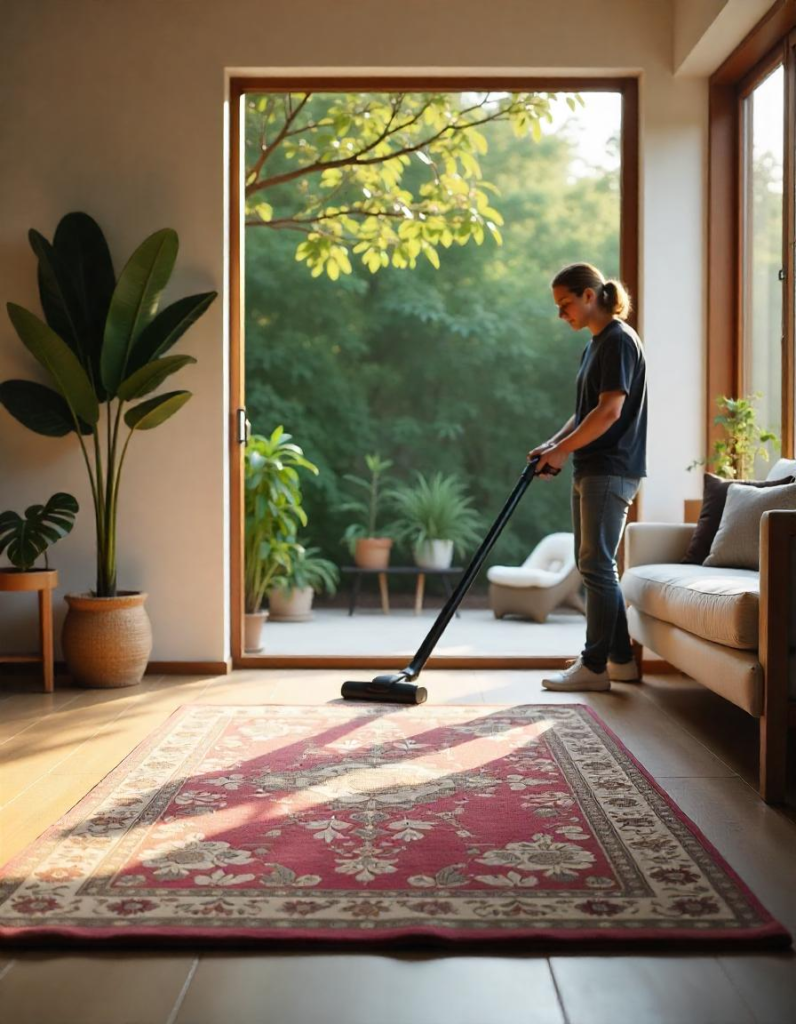
Seattle’s Unique Climate Challenges
The Pacific Northwest’s climate creates specific issues for rug owners:
| Seattle Climate Factor | Impact on Rugs | Professional Solution |
| High rainfall (37″ annually) | Increased humidity in homes | Thorough extraction and controlled drying |
| Limited sunny days | Difficulty properly drying rugs outdoors | Climate-controlled drying rooms |
| Mild temperatures year-round | Continuous biological growth | Anti-microbial treatments |
| Urban environment | Increased pollutants and fine particulates | Deep cleaning beyond surface level |
The Seattle Department of Public Health recommends professional cleaning for all household textiles at least annually to reduce allergen buildup associated with our climate Seattle DPH, 2024.
Health Benefits of Regular Professional Rug Cleaning
Beyond aesthetics, professionally cleaned rugs contribute significantly to indoor air quality. Research from the American Lung Association indicates that thorough professional cleaning can remove:
- Up to 98% of common allergens
- Over 85% of trapped bacteria
- Nearly all dust mites and their waste products
- Mold spores before they can proliferate
For Seattle residents with asthma or allergies, this reduction in triggers can dramatically improve quality of life.
Extending the Lifespan of Valuable Rugs
Professional cleaning removes the abrasive grit and debris that gradually cut and wear down rug fibers. Additionally, Seattle’s professional rug cleaners can:
- Restore proper pH balance to fibers
- Remove damaging salt residue tracked in during winter
- Identify and treat moth infestations before irreparable damage occurs
- Apply appropriate protective treatments specific to fiber types
Case Study: The Seattle Art Museum’s textile conservation department estimates that professional cleaning can extend a quality rug’s lifespan by 15-20 years compared to rugs that receive only regular vacuuming.
Seasonal Cleaning Recommendations for Seattle
For optimal rug care in Seattle, professionals recommend:
- Spring cleaning: Remove winter salt residues and address moisture issues
- Fall cleaning: Prepare rugs for the closed-window season when indoor air quality becomes more critical
- Additional cleaning: After renovations, moving, pet accidents, or spills
Professional Rug Cleaning Methods in Seattle

Hot Water Extraction/Steam Cleaning
This method, often referred to as “steam cleaning” (though it doesn’t actually use steam), remains the gold standard for many types of rugs. Seattle’s top rug cleaners use truck-mounted equipment that provides:
- Water heated to optimal temperature (not too hot for delicate fibers)
- Powerful extraction that removes up to 95% of moisture
- Carefully controlled pressure settings are adjusted for each rug type
- Eco-friendly cleaning solutions are appropriate for Seattle’s watershed protection regulations
Best for: Synthetic rugs, many wool rugs, and heavily soiled areas
Dry Cleaning Methods
Several “low-moisture” cleaning approaches are available from Seattle’s rug specialists:
- Encapsulation cleaning: Using crystallizing polymers that trap dirt for vacuuming
- Absorbent compound cleaning: Applying moistened compounds that attract and bind with soil
- Dry foam cleaning: Using minimal moisture with specialized foaming agents
Best for: Delicate rugs, natural fiber rugs sensitive to moisture, and situations requiring quick drying times
Hand Washing for Delicate Rugs
Seattle’s premier rug cleaning specialists offer true hand washing for the most valuable and delicate rugs. This process typically includes:
- Gentle dusting and soil removal
- Immersion in temperature-controlled baths
- Careful agitation by hand (never machines)
- Multiple rinse cycles
- Controlled drying in specially designed facilities
- Hand finishing and fringe detailing
Best for: Antique rugs, Persian and Oriental rugs, silk rugs, and other high-value pieces
Specialized Treatments for Stains and Odors
Professional rug cleaners in Seattle offer targeted solutions for common issues:
- Pet urine decontamination (particularly important in Seattle’s dog-friendly culture)
- Red wine and coffee stain removal
- Mold remediation for rugs exposed to excessive moisture
- Smoke odor elimination
- Allergen reduction treatments
Eco-Friendly Cleaning Options in Seattle
In environmentally conscious Seattle, many professional cleaners offer green cleaning solutions:
- Plant-based cleaning agents
- Reduced water usage methods
- Biodegradable spotting treatments
- Chemical-free options for sensitive individuals
Leading Seattle rug cleaners like EcoClean and Green Earth Cleaning have developed proprietary methods that meet both King County’s strict environmental standards and the needs of health-conscious consumers.
How to Choose the Best Rug Cleaning Service in Seattle

Credentials and Certifications to Look For
When selecting a professional rug cleaner in Seattle, verify these important qualifications:
- IICRC Certification: The Institute of Inspection, Cleaning and Restoration Certification sets industry standards
- WoolSafe Approval: Important for cleaning wool rugs safely
- Master Rug Cleaner Certification: Advanced training specific to rugs (rather than general carpet cleaning)
These credentials indicate a commitment to ongoing education and adherence to industry best practices.
Experience with Specific Rug Types
Seattle’s diverse housing inventory includes everything from modern downtown condos to historic Craftsman homes in Ballard and Queen Anne, each typically featuring different types of rugs. When interviewing potential cleaners, ask about their experience with your specific rug type:
- How many years have they been cleaning your type of rug?
- Do they have a dedicated facility for rug cleaning (preferably), or do they clean on-site?
- Can they provide examples of similar rugs they’ve successfully cleaned?
- What specific process do they use for your rug’s materials?
Insurance and Guarantees
Professional rug cleaners should provide:
- Comprehensive insurance coverage: Protection in case of damage during cleaning or transport
- Written guarantees: Clear policies regarding customer satisfaction
- Transparent pricing: No hidden fees or unexpected charges
In Seattle’s competitive market, reputable cleaners stand behind their work with strong guarantees.
Reading Reviews and Testimonials
When researching Seattle rug cleaners, look beyond the star ratings to find specific information about:
- Timeliness and reliability
- Communication throughout the process
- How they handled any challenges or difficult stains
- Whether they addressed special requests appropriately
- Long-term results after cleaning
Local platforms like Nextdoor and Seattle-specific forums often provide more detailed neighborhood recommendations than general review sites.
Questions to Ask Potential Service Providers
Before scheduling service, ask:
- “Do you provide a written estimate before beginning work?” (They should)
- “What cleaning method do you recommend for my specific rug, and why?” (Their answer reveals expertise.)
- “How long have you been cleaning rugs in Seattle?” (Experience with local conditions matters)
- “Do you clean in a dedicated facility or in my home?” (Facility cleaning is generally more thorough)
- “What drying methods do you use?” (Important in Seattle’s humid environment)
- “Can you provide references from clients with similar rugs?” (Willingness indicates confidence)
DIY vs. Professional Rug Cleaning in Seattle
When DIY Is Appropriate
For Seattle homeowners, some rug maintenance can be handled without professional help:
- Regular vacuuming: Essential in Seattle’s environment, use HEPA-filtered vacuums
- Immediate blotting of spills: Using clean white cloths and plain water
- Minor spot cleaning: Following the manufacturer’s guidelines for specific rug types
- Rotating rugs: Every 6 months to promote even wear
However, DIY methods have significant limitations, especially in Seattle’s climate.
When to Call the Professionals
Professional cleaning is strongly recommended:
- At least annually for all rugs (more frequently in homes with pets, children, or high traffic)
- After water exposure or flooding (common during Seattle’s rainy season)
- When dealing with stubborn stains that basic spot cleaning won’t remove
- For valuable or antique rugs (always)
- When rugs develop odors despite regular vacuuming
- If anyone in the household has respiratory sensitivities or allergies
Cost Comparison
While DIY cleaning appears less expensive initially, consider the full picture:
| Aspect | DIY Approach | Professional Service |
| Upfront cost | $30-150 for rental equipment | $150-600+, depending on rug size and type |
| Risk of damage | High, especially for valuable rugs | Low with reputable professionals |
| Effectiveness | Surface cleaning only | Deep cleaning, including backing |
| Time investment | 4-8 hours of personal time | Minimal (drop-off or brief home visit) |
| Equipment quality | Consumer-grade | Commercial-grade |
| Long-term cost | Potential rug replacement | Extended rug lifespan |
Risk Assessment for Valuable Rugs
For rugs valued over $1,000, DIY cleaning poses significant risks:
- Color bleeding from improper techniques
- Fiber damage from excessive moisture
- Backing deterioration from slow drying
- Shrinkage from improper drying methods
- Voided warranties from manufacturers
According to the National Institute of Rug Cleaners, approximately 85% of rug damage they assess results from improper cleaning attempts rather than normal wear and tear.
Cost of Professional Rug Cleaning in Seattle
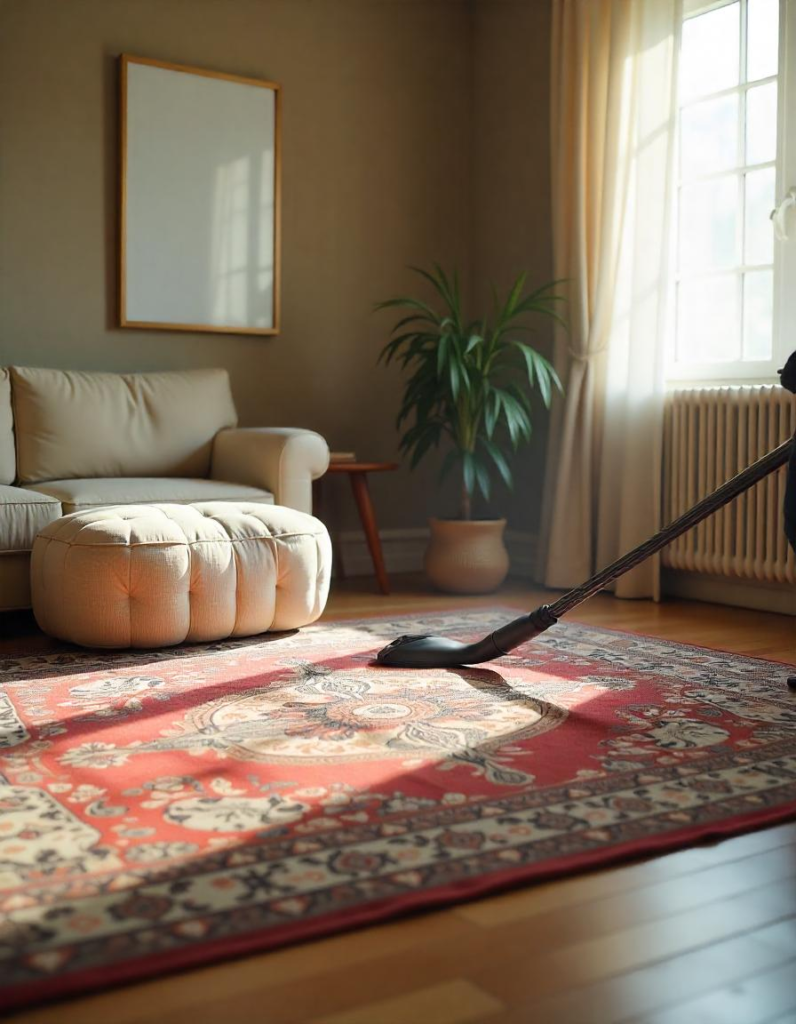
Average Pricing by Rug Size
Seattle rug cleaning prices typically fall within these ranges:
| Rug Size | Synthetic | Wool/Natural Fiber | Oriental/Persian |
| 3′ x 5′ | $75-125 | $100-150 | $150-300 |
| 5′ x 8′ | $125-200 | $175-300 | $300-600 |
| 8′ x 10′ | $200-350 | $300-500 | $500-1000 |
| 9′ x 12′ | $275-450 | $400-700 | $700-1500 |
Note: Prices may be higher for rugs with specific challenges like heavy soiling, pet stains, or damage requiring repair.
Additional Services and Their Costs
Many Seattle rug cleaners offer supplementary services:
- Stain protection treatment: $0.50-1.50 per square foot
- Pet odor treatment: $50-200, depending on severity
- Moth prevention treatment: $30-100
- Fringe cleaning/repair: $3-10 per linear foot
- Padding replacement: $1-3 per square foot
- Pick-up and delivery: $30-75 (often waived above certain order values)
Value Considerations
When evaluating cleaning costs, consider:
- The replacement value of your rug
- Health benefits from allergen removal
- An extended rug lifespan from proper maintenance
- The cost of potential damage from improper cleaning
Expert Insight: “Professional cleaning is the single most important factor in extending a rug’s usable life, often adding decades to fine rugs when performed regularly.” – Jessica Bautista, Textile Conservator at the Seattle Art Museum
Seasonal Discounts and Promotions
Many Seattle rug cleaners offer periodic specials:
- January/February post-holiday specials (typically 15-20% off)
- Spring cleaning promotions (March-May)
- End of summer deals (August-September)
- Multiple rug discounts (10-15% for additional rugs)
- New customer incentives
- Referral programs
Following local cleaning companies on social media or joining their email lists provides notifications of these opportunities.
The Rug Cleaning Process in Seattle

Initial Inspection and Assessment
Professional rug cleaning in Seattle begins with a thorough examination:
- Identification of rug type and materials: Determining fiber content, construction method, and age
- Pre-cleaning assessment: Documenting existing conditions, including damage, wear patterns, and previous repairs
- Stain analysis: Identifying the nature of spots and discolorations to determine appropriate treatments
- Treatment planning: Creating a customized cleaning approach based on the rug’s specific needs
The Washington State Cleaning Association recommends that “all textile cleaning should begin with proper assessment to prevent damage from inappropriate cleaning methods,” WSCA Guidelines, 2024.
Pre-Treatment Procedures
Before the main cleaning begins, professional rug cleaners in Seattle typically:
- Dust removal: Using specialized equipment that vibrates loose dirt from deep within the rug (removing up to 1-2 pounds of soil from an average 8×10 rug)
- Spot pre-treatment: Applying targeted solutions to address specific stains
- Fringe pre-conditioning: Treating rug fringes with appropriate protective agents
- pH balancing: Preparing the rug for optimal cleaning solution effectiveness
Expert Tip: “The dusting process alone removes approximately 80% of dry soil from rugs, making it perhaps the most critical step in the cleaning process,” notes Robert Hamm, Director of the Pacific Northwest Rug Cleaners Association.
Cleaning Process
Depending on the rug type and condition, Seattle’s professional cleaners will select from several cleaning approaches:
- Immersion washing: Full submersion in temperature-controlled baths (for rugs that can tolerate complete wetting)
- Surface cleaning: Controlled application of cleaning agents with limited moisture
- Specialized spot treatments: Using techniques appropriate for specific stains
- Gentle agitation: Either by hand or with soft-bristled equipment to lift embedded soil
Throughout the process, technicians monitor:
- Water temperature
- Solution strength
- Dwell time
- Mechanical action
- pH levels
Drying Methods
In Seattle’s humid climate, proper drying is critical to prevent mold growth and fiber damage. Professional facilities use:
- Climate-controlled drying rooms: Maintaining optimal temperature and humidity levels
- Air movement systems: Creating consistent airflow across the entire rug
- Tension drying systems: For rugs requiring precise shape maintenance
- Dehumidification equipment: Accelerating moisture removal without heat damage
The Environmental Protection Agency notes that “proper drying of textiles within 24-48 hours is essential to prevent microbial growth in Seattle’s climate,” EPA Indoor Air Guidelines, 2023.
Post-Cleaning Quality Control
Before returning a rug to its owner, reputable Seattle cleaning companies perform:
- Final inspection: Checking that all stains and soiling have been adequately addressed
- Grooming: Restoring proper pile direction and appearance
- Fringe detailing: Ensuring fringes are clean and properly aligned
- pH testing: Confirming that the rug has returned to an appropriate pH level
- Documentation: Providing before/after photos and treatment records
Maintaining Your Rugs Between Professional Cleanings
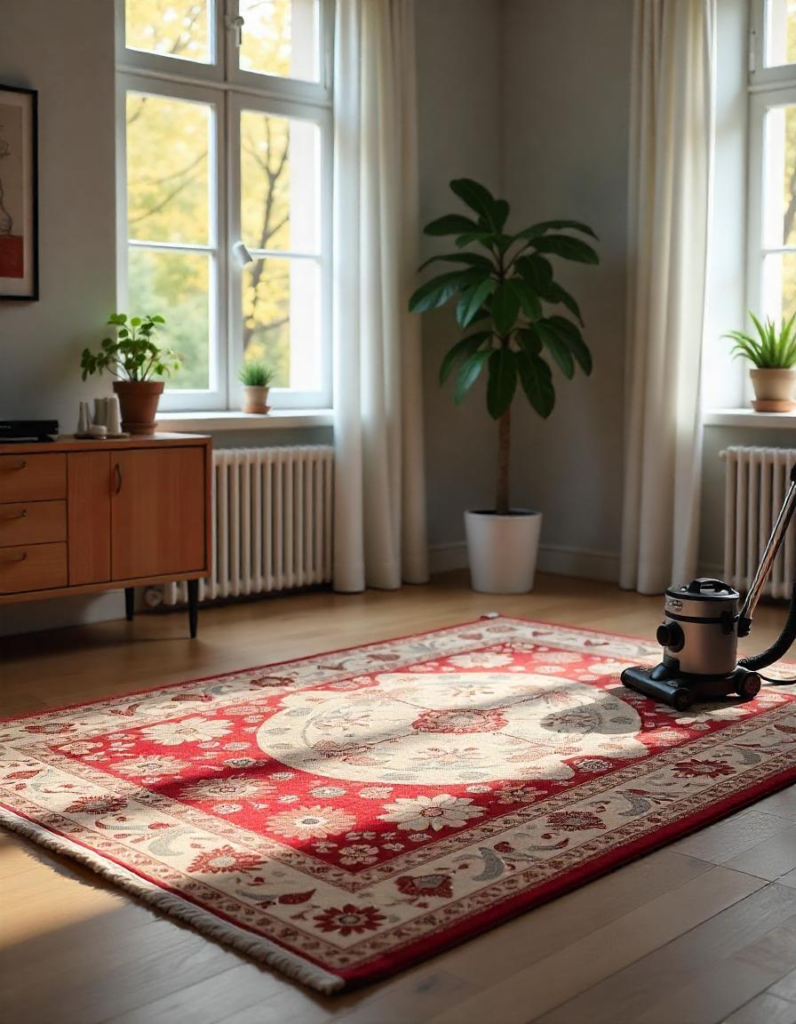
Regular Vacuuming Techniques
Proper vacuuming is especially important in Seattle homes:
- Frequency: Weekly for most areas, twice weekly for high-traffic zones
- Equipment: Use vacuums with adjustable height settings and HEPA filtration
- Technique: Vacuum in multiple directions to reach dirt from all angles
- Special consideration: Always vacuum with the grain on fringed rugs
- Power settings: Use lower suction settings on delicate or antique rugs
Important: Disable beater bars/rotating brushes when vacuuming delicate, high-pile, or fringed rugs.
Spot Cleaning Recommendations
For immediate spill response in Seattle homes:
- Blot immediately: Use clean white cloths or paper towels to absorb liquids (never rub)
- Plain water first: Try cool water before any cleaning products
- Test cleaning solutions: Always test in an inconspicuous area before applying
- Work from outside in: Clean from the perimeter toward the center to prevent spreading
- Minimize moisture: Use as little liquid as possible, especially important in Seattle’s damp climate
- Avoid DIY remedies: Common household solutions like vinegar or baking soda can damage some rug fibers and dyes
Rotation and Placement Tips
To extend the life of rugs in Seattle homes:
- Rotate rugs 180 degrees every 6 months: Ensures even wear, especially important in rooms with large windows where sun exposure is uneven
- Use rug pads: provide cushioning, prevent slipping, and allow airflow beneath rugs
- Avoid direct sunlight when possible: Seattle’s summer sun through windows can fade rug colors over time
- Keep rugs away from fireplaces: Even with screens, embers can cause damage
- Consider seasonal storage: For lightweight rugs in extremely high-humidity areas
Protecting Rugs from Seattle Weather Conditions
Seattle’s climate requires special consideration:
- Entryway protection: Use walk-off mats at all entrances to reduce tracked-in moisture and debris
- Humidity management: Consider dehumidifiers during the wettest months (November-February)
- Shoe policies: Implement a no-shoes policy to reduce dirt and moisture transfer
- Quick response to water: Address any water exposure immediately, especially during Seattle’s rainy season
According to the Carpet and Rug Institute, “addressing moisture within the first 24-48 hours prevents most long-term damage and mold issues,” CRI Care Guidelines, 2024.
Finding the Best Rug Cleaning Services in Seattle

Top-Rated Seattle Rug Cleaning Specialists
Several established companies have earned sterling reputations in the Seattle area:
- Seattle Rug Spa: Specializing in Oriental and Persian rugs with on-site cleaning facility
- Puget Sound Rug Cleaners: Certified in wool care and restoration
- Pacific Northwest Rug Gallery: Offering museum-quality hand cleaning for valuable pieces
- Green Earth Rug Care: Eco-friendly cleaning options with biodegradable solutions
- Queen Anne Rug Works: Specializing in antique and heirloom rug restoration
When researching these or other companies, verify their specific expertise matches your rug’s requirements.
Service Areas Throughout Greater Seattle
Most professional rug cleaners service the entire Seattle metropolitan area, including:
- Downtown Seattle
- Queen Anne and Magnolia
- Capitol Hill and Central District
- Ballard, Fremont, and Wallingford
- University District and Ravenna
- West Seattle and South Seattle
- Bellevue, Kirkland, and Redmond
- Mercer Island
- Shoreline and Edmonds
- Renton and Kent
Many offer pick-up and delivery services throughout these areas, with some extending to Tacoma and Everett for an additional fee.
What to Expect During Your First Professional Cleaning
For first-time customers, the process typically follows these steps:
- Initial consultation: Either by phone, online, or in person
- Scheduling: Pick-up or drop-off arrangements
- Pre-cleaning inspection: Often with photos and documentation
- Estimate approval: Based on rug size, type, and condition
- Cleaning process: Typically 3-7 days, depending on the company and rug needs
- Return delivery: With post-cleaning care instructions
Most Seattle rug cleaners offer satisfaction guarantees for first-time customers.
Conclusion: Investing in Your Seattle Home’s Rugs
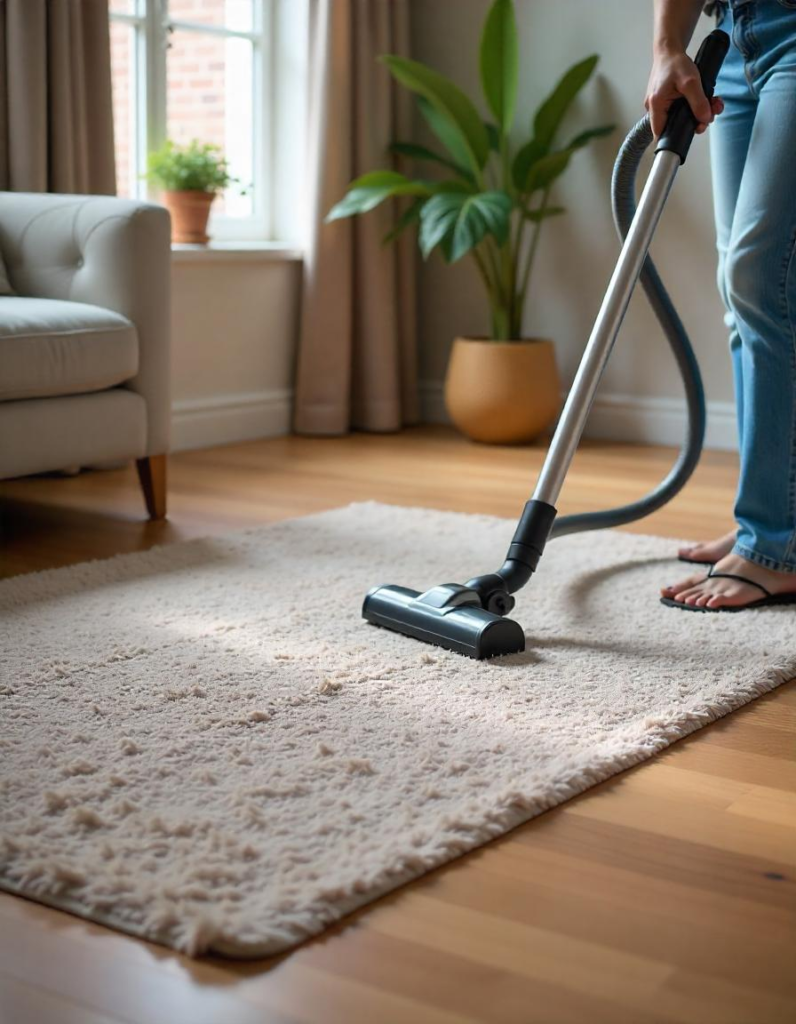
The Value of Regular Professional Rug Cleaning
Maintaining your rugs through professional cleaning is both a health investment and a financial one:
- Health benefits: Reduced allergens and improved indoor air quality, particularly important in Seattle’s indoor-focused rainy season
- Preservation of value: Protecting what are often significant financial investments
- Aesthetic maintenance: Keeping your Seattle home looking its best year-round
- Sustainability: Extending the life of quality textiles aligns with Seattle’s environmental values
Final Recommendations for Seattle Rug Owners
To maintain beautiful, long-lasting rugs in Seattle:
- Schedule professional cleaning: At least annually for most rugs, semi-annually for high-traffic areas or homes with pets
- Vacuum regularly: Use appropriate techniques and equipment
- Address spills immediately: Following proper spot cleaning protocols
- Use quality rug pads: Appropriate for your specific flooring type
- Consider Seattle’s climate: Take extra precautions during the wettest months
Seattle Rug Cleaning Seasonal Calendar
| Season | Recommended Rug Care Actions |
| Winter (Dec-Feb) | – Use entry mats for snow/salt protection<br>- Consider humidity control<br>- Schedule post-holiday cleaning |
| Spring (Mar-May) | – Deep professional cleaning<br>- Address any winter moisture issues<br>- Treat for moths before summer |
| Summer (Jun-Aug) | – Protect from direct sunlight<br>- Consider rotating rugs<br>- Good time for repair work |
| Fall (Sep-Nov) | – Pre-winter professional cleaning<br>- Focus on entryway rugs<br>- Apply protective treatments |
By following these recommendations and working with Seattle’s professional rug cleaning specialists, your valuable floor coverings will remain beautiful, clean, and in excellent condition for many years to come—even in Seattle’s challenging climate.
Ready to schedule your professional rug cleaning? Most Seattle rug cleaning specialists offer free consultations to help you determine the best approach for your specific rugs and needs.
